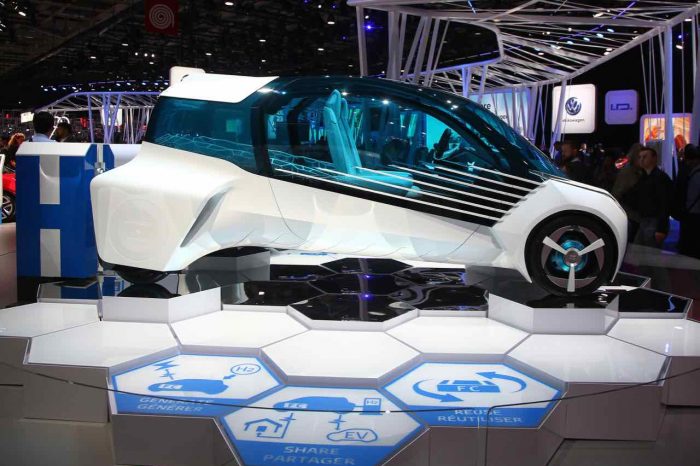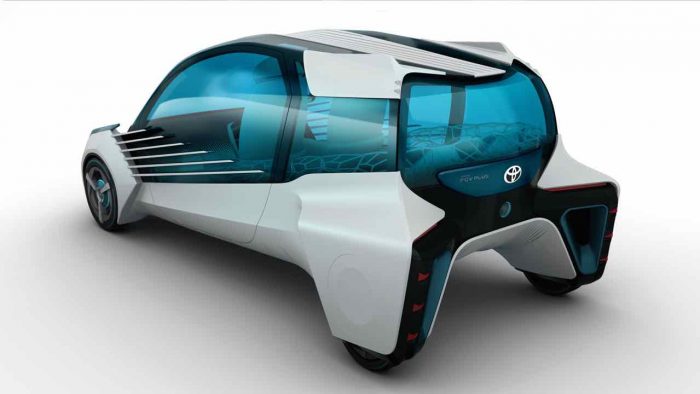Toyota FCV Plus, ¿coche o central eléctrica?
El año pasado, tras desarrollar su vehículo de pila de combustible, desde el prototipo Toyota FCV Concept hasta el Toyota Mirai 2015, un coche de producción con todas las de la ley que ya se vende en algunos mercados, la marca nipona dio a conocer el Toyota FCV Plus, un vehículo impulsado por hidrógeno que también fue diseñado para ser una fuente de energía propia. Ahora, tras el Salón de París, concoemos muchos más detalles.

Tres funciones en un coche: garantizar movilidad, compartir energía y apoyar la generación eléctrica futura (de igual modo que hoy un teléfono sirve para multitud de cosas además de llamar -es cámara fotográfica, se conecta a Internet…-. Llama la atención cómo han sido capaces los ingenieros nipones de reducir el tamaño de la pila de combustible y otros componentes, hasta el punto de que el Toyota FCV Plus tenga dimensiones muy compactas (3.800 mm de longitud), perfecto para la ciudad, sin renunciar a una cuidada aerodinámica.
Y ojo, que es amplio por dentro. Se han ubicado las ruedas en las esquinas) movidas cada una por un motor independiente), con la célula de combustible situada entre las delanteras y el depósito de hidrógeno entre las traseras, para maximizar el tamaño del habitáculo, que cuenta con un interior realizado com piezas impresas en 3D.

Además de generar electricidad a partir del hidrógeno en su propio depósito, puede emplear hidrógeno a partir de una fuente externa (un depósito auxiliar puede conectarse al coche para generar electicidad, no necesariamente para conducir, sin tener que gastar del depósito de combustible). Otra opción interesante es que puede retirarse la pila de combustible de entre las ruedas delanteras, y utilizarlo como generador portátil. Y para cargar otros vehículos hay paneles de carga inalámbrica en las ruedas traseras y bajo del piso delantero. En el parabrisas y en la luna trasera una serie de símbolos anuncian el estado en el que se encuentra el coche durante el estacionamiento.
No, no verás un Toyota Mirai Plus. Desde la marca cuentan que para que un vehículo así llegue a las calles se necesita al menos una docena de años más de desarrollo. Antes deben popularizarse los coches de hidrógeno y en eso anda, pues en París contaron que esperan producir 30.000 coches de pila de combustible en los próximos años. Como concepto versátil, desde luego que tiene futuro.
------------------------
Last year, after developing its fuel cell vehicle, from the prototype Toyota FCV Concept to the Toyota Mirai 2015, a production car with all the law that is already sold in some markets, the Japanese brand unveiled the Toyota FCV Plus, a hydrogen-powered vehicle that was also designed to be its own power source. Now, after the Paris Salon, let's get acquainted with many more details.
The underlying idea is based on the premise that while Toyota FCV Plus can run on clean fuel, other energy consumers may not. As such, the car is designed to function as a clean energy source and operate as part of the "electric power generation infrastructure". It is also about helping to address energy security problems according to the brand.
Toyota FCV Plus Concept 2016 Paris - 4
Three functions in a car: to guarantee mobility, to share energy and to support future electricity generation (just as today a telephone is used for a multitude of things besides calling - it is a camera, it connects to the Internet ... - It is striking how Japanese engineers have been able to reduce the size of the fuel cell and other components, to the point that the Toyota FCV Plus has very compact dimensions (3.800 mm in length), perfect for the city, without sacrificing aerodynamics.
And eye, which is wide inside. The wheels are located in the corners) each moved by an independent motor), with the fuel cell located between the front and the hydrogen tank between the rear, to maximize the size of the passenger compartment, which has an interior made with Pieces printed in 3D.
Toyota FCV Plus Concept 2016 - 1
In addition to generating electricity from hydrogen in its own tank, it can use hydrogen from an external source (an auxiliary tank can be connected to the car to generate electricity, not necessarily to drive, without having to spend from the fuel tank). Another interesting option is that you can remove the fuel cell from between the front wheels, and use it as a portable generator. And to load other vehicles there are wireless load panels on the rear wheels and under the front floor. On the windshield and the rear moon a series of symbols announce the state in which the car is in the parking lot.
No, you will not see a Toyota Mirai Plus. From the brand count that for such a vehicle to reach the streets takes at least a dozen more years of development. Before the hydrogen cars should be popularized and in that walks, because in Paris they counted that they expect to produce 30,000 cars of fuel pile in the next years. As a versatile concept, it certainly has a future.
No comments:
Post a Comment